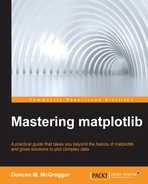We covered some interesting ground in this chapter. We explored the fascinating world of satellite imagery, showing with just a few lines of code how to work with it. Hitting the hardware limitations of a modest workstation, we uncovered a straightforward use case to put matplotlib in the Cloud. Docker provides a fresh outlook towards the world of configuration management and does so in a way that has a very low barrier to entry. It uses the existing Linux skills that many developers may have already gained by the time they reach the early stages of an advanced level. Working with Docker in EC2 and S3 proved to be painless, as it offers an array of potential ways to extend the initial workflow. Furthermore, the use of Docker provides for a no-lock-in scenario with the Cloud vendors. As soon as you identify a provider with better data transfer rates, features on instances, or price, you'll be able to make the switch due to the ubiquity of Docker in Cloud environments. In the next chapter, we will continue with our foray into the Cloud environments and distributed workloads, where we will explore some topics in the arena of large datasets.
